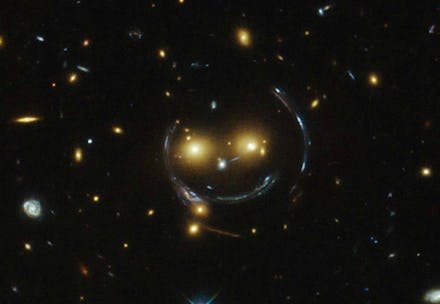NASA Just Spotted a Smiley Face in Space — And What's Causing It Is Mind-Blowing

The universe is smiling on you today.
At first, this may seem like an optical illusion: After all, the human brain is wired to see human faces in everything, a psychological phenomenon known as pareidolia. But the scientific explanation for this remarkable collection of stars is far more interesting.
According to NASA, "Galaxy clusters are the most massive structures in the universe and exert such a powerful gravitational pull that they warp the spacetime around them and act as cosmic lenses which can magnify, distort and bend the light behind them. This phenomenon, crucial to many of Hubble's discoveries, can be explained by Einstein's theory of general relativity."
In this special case of gravitational lensing, the bending of light by gravity produces a ring — called an Einstein Ring — like the outline of a face captured in this Hubble photo.
"Let's start with the eyes. They're not stars, but entire galaxies — groups of 100 billion or more stars packed together, like our Milky Way," explains Vox's Joseph Stromberg. "These galaxies are so large that traveling across them at the speed of light would take you hundreds of thousands of years or more. And each of these stars, astronomers now believe, likely has a planet orbiting it. It's very possible that among the hundreds of billions of planets in each of those eyes, there's some form of alien life."
h/t Vox
Editor's Note: Feb. 25, 2015
An earlier version of this article cited NASA information, but did not include quotations around the cited passage. The story has been updated to fully attribute NASA's language.